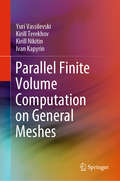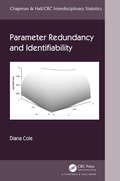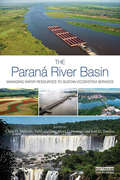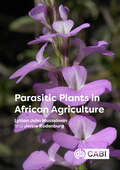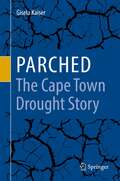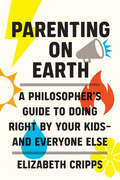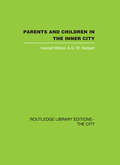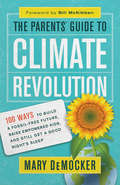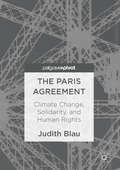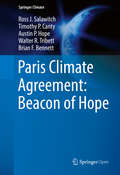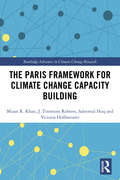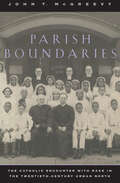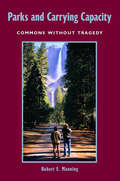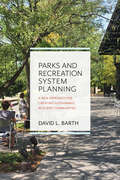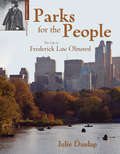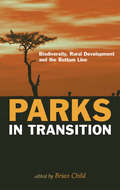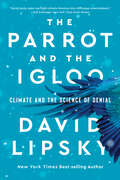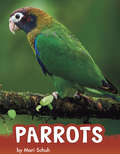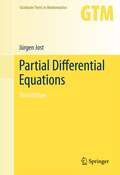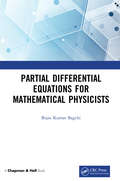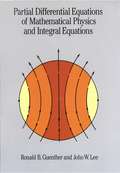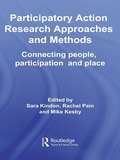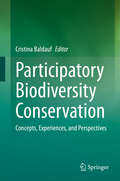- Table View
- List View
Parallel Finite Volume Computation on General Meshes
by Yuri Vassilevski Kirill Terekhov Kirill Nikitin Ivan KapyrinThis book presents a systematic methodology for the development of parallel multi-physics models and its implementation in geophysical and biomedical applications. The methodology includes conservative discretization methods for partial differential equations on general meshes, as well as data structures and algorithms for organizing parallel simulations on general meshes. The structures and algorithms form the core of the INMOST (Integrated Numerical Modelling Object-oriented Supercomputing Technologies) platform for the development of parallel models on general meshes. The authors consider applications for addressing specific geophysical and biomedical challenges, including radioactive contaminant propagation with subsurface waters, reservoir simulation, and clot formation in blood flows. The book gathers all the components of this methodology, from algorithms and numerical methods to the open-source software, as well as examples of practical applications, in a single source, making it a valuable asset for applied mathematicians, computer scientists, and engineers alike.
Parameter Redundancy and Identifiability (Chapman & Hall/CRC Interdisciplinary Statistics)
by Diana ColeStatistical and mathematical models are defined by parameters that describe different characteristics of those models. Ideally it would be possible to find parameter estimates for every parameter in that model, but, in some cases, this is not possible. For example, two parameters that only ever appear in the model as a product could not be estimated individually; only the product can be estimated. Such a model is said to be parameter redundant, or the parameters are described as non-identifiable. This book explains why parameter redundancy and non-identifiability is a problem and the different methods that can be used for detection, including in a Bayesian context. Key features of this book: Detailed discussion of the problems caused by parameter redundancy and non-identifiability Explanation of the different general methods for detecting parameter redundancy and non-identifiability, including symbolic algebra and numerical methods Chapter on Bayesian identifiability Throughout illustrative examples are used to clearly demonstrate each problem and method. Maple and R code are available for these examples More in-depth focus on the areas of discrete and continuous state-space models and ecological statistics, including methods that have been specifically developed for each of these areas This book is designed to make parameter redundancy and non-identifiability accessible and understandable to a wide audience from masters and PhD students to researchers, from mathematicians and statisticians to practitioners using mathematical or statistical models.
Parameterization Schemes
by David J. StensrudNumerical weather prediction models play an increasingly important role in meteorology, both in short- and medium-range forecasting and global climate change studies. The most important components of any numerical weather prediction model are the subgrid-scale parameterization schemes, and the analysis and understanding of these schemes is a key aspect of numerical weather prediction. This book provides in-depth explorations of the most commonly used types of parameterization schemes that influence both short-range weather forecasts and global climate models. Several parameterizations are summarised and compared, followed by a discussion of their limitations. Review questions at the end of each chapter enable readers to monitor their understanding of the topics covered, and solutions are available to instructors at www. cambridge. org/9780521865401. This will be an essential reference for academic researchers, meteorologists, weather forecasters, and graduate students interested in numerical weather prediction and its use in weather forecasting.
The Paraná River Basin: Managing Water Resources to Sustain Ecosystem Services (Earthscan Series on Major River Basins of the World)
by Chris D. MetcalfeThis book provides insight into the hydrology, ecosystem services and management of water resources in the Paraná River basin, including the importance of water to the socio-economic development of the countries within the watershed. Running through Brazil. Paraguay and Argentina, the Paraná River and its watershed is home to some of South America's major population centers as well as important ecosystems threatened by development. At the same time, the river is a major resource driving the economies of the nations within its boundaries. This volume examines the impacts of environmental degradation, and the tradeoffs between the energy sector and the maintenance of ecosystem services. In particular, it focuses on the threats from development to sensitive ecosystems within the basin and the challenges of transboundary management of water resources. In addition to presenting wider perspectives on water management, the volume specifically covers water infrastructure, aquatic ecosystems, water quality, geomorphological influences and the impact of climate change. Finally, by assessing each country's current status in meeting the Sustainable Development Goals this volume provides a timely analysis as national governments within the basin are becoming increasingly concerned about the sustainability of the freshwater ecosystems within the Paraná River basin. This book will be of great interest to students and scholars of water and natural resource management, environmental policy, sustainable development and Latin American studies. It will also be relevant to water management professionals.
Parasitic Plants in African Agriculture
by Professor Lytton John Musselman Dr Jonne RodenburgParasitic Plants in African Agriculture brings together for the first time in a single volume, the ecology, biology, damage, and control of all groups of African parasitic plants including both the relatively few parasites introduced to the continent as well as those native parasites that have spread from within Africa. The book covers the well-known witchweeds and broomrapes but also groups and species that have received less attention including mistletoes, dodders, rice vampire weed, and other species posing threats. The book distinguishes between stem and root parasitic weeds and between holoparasites and (facultative or obligate) hemiparasites. Based on their research and experience collectively spanning six decades, the authors provide an authoritative and state-of-the-art overview of the distribution, biology and impact of these highly specialized weeds and include recommendations for their management. Since parasitic plants in African agriculture primarily affect smallholder farmers, these weeds are explicitly discussed within a context of resource limitations and global changes. Readers are informed on all parasitic plant species relevant to African agriculture and the impact these plants have on crop production and livelihoods of smallholders in a changing world. Current and future management strategies are outlined in terms of their principles and effectiveness as well as their feasibility and affordability for farmers, all of which determine farmer adoption. The final chapter synthesises some of the relevant findings and statistics regarding parasitic weed distribution and their host crops and discusses implications in terms of future crop protection concerns in African agricultural systems. Key features: · Authoritative text based on extensive field and laboratory work. · First comprehensive state-of-the-art overview of parasitic plants and their management in Africa. · Highly illustrated with photos, graphs and species distribution maps. · Reviews previous basic and applied work, with relevance to smallholder farming systems. This book will be a valuable reference for students, researchers, extension workers, development officers, national agriculture researchers, plant pathologists, food security specialists, weed scientists, agronomists and botanists.
Parched - The Cape Town Drought Story
by Gisela KaiserThe book presents the history of water supply to Cape Town, leading up to the worst ever drought recorded, through political turmoil impacting on drought interventions and resulting in the adoption of an integrated water strategy.Regions reliant on water supply from rainfed dams have always been vulnerable to the impact of drought. This is exacerbated by the uncertainty of future rainfall, which is never guaranteed, and reliance is placed on modelling using historic data. While weather has always been variable, climate has been generally reliable. With anthropogenic activity causing changes in climate, the validity of modelling based on history is currently not fully trusted. Unless the storage capacity is sufficient to carry through numerous seasons of poor rainfall, even with water restrictions to match demand and supply in times of depleted rainfall, the risk of reservoirs running dry remains a threat.
Parenting on Earth: A Philosopher's Guide to Doing Right by Your Kids and Everyone Else
by Elizabeth CrippsBeing parents and being human: building hope for our children in a fragile world.Environmental catastrophes, pandemics, antibiotic resistance, institutionalized injustice, and war: in a world so out of balance, what does it take—or even mean—to be a good parent? This book is one woman&’s search for an answer, as a moral philosopher, activist, and mother.Drawing on the insights of philosophy and the experience of parent activists, Elizabeth Cripps calls for parents to think radically about exactly what we owe our children—and everyone else. She shows how our children&’s needs are inseparable from the fate of the earth and the fortunes of others and how much is at stake in parenting today. And she asks the hardest question: should we have kids at all?Timely and thoughtful, Parenting on Earth extends a challenge to anyone raising children in a troubled world—and with it, a vision of hope for our children&’s future. Cripps envisions a world where kids can prosper and grow—a just world, with thriving social systems and ecosystems, where future generations can flourish and all children can lead a decent life. She explains, with bracing clarity, why those raising kids today should be a force for change and bring up their children to do the same. Hard as this can be, in the face of political gridlock, ecoanxiety, and general daily grind, the tools of philosophy and psychology can help us find a way.
Parents and Children in the Inner City
by Harriett Wilson G.W. HerbertThis book was first published in 1978.
The Parents’ Guide to Climate Revolution: 100 Ways to Build a Fossil-Free Future, Raise Empowered Kids, and Still Get a Good Night’s Sleep
by Bill McKibben Mary DeMocker“Relax,” writes author Mary DeMocker, “this isn’t another light bulb list. It’s not another overwhelming pile of parental ‘to dos’ designed to shrink your family’s carbon footprint through eco-superheroism.” Instead, DeMocker lays out a lively, empowering, and doable blueprint for engaging families in the urgent endeavor of climate revolution. In this book’s brief, action-packed chapters, you’ll learn hundreds of wide-ranging ideas for being part of the revolution — from embracing simplicity parenting, to freeing yourself from dead-end science debates, to teaching kids about the power of creative protest, to changing your lifestyle in ways that deepen family bonds, improve moods, and reduce your impact on the Earth. Engaging and creative, this vital resource is for everyone who wants to act effectively — and empower children to do the same.
Parícutin: The Life and Death of a Volcano (Fountas & Pinnell LLI Purple #Level R)
by Laura TabbertThe ground swelled and raised itself... Fine dust, like ashes, began to rise from the crack. Smoke began to rise with a loud hiss.
The Paris Agreement
by Judith BlauThis book discusses the immediate and severe threat posed by global climate change and the various obstacles that stand in the way of action. Judith Blau presents scientific evidence relevant to The Paris Agreement (COP-21): an international treaty that promises to strengthen the global response to climate change. As she reckons with the dangers of catastrophic planetary heating, Blau discusses the clash between the deeply ingrained American tradition of individualism and the collective action and acknowledgement of intertwined fate needed to address climate change. She acknowledges that America's capitalist bent stands in contrast to the idea of the "commons"--a concept that we need to embrace if climate change is to be mitigated. The volume also explains the foundations of international human rights standards as they relate to climate change. Drawing from guiding principles of human rights and equality, the book concludes hopefully--suggesting that the people of the world can meet the challenge posed by climate change by at once acknowledging shared humanity and celebrating difference.
Paris Climate Agreement: Beacon of Hope
by Ross J. Salawitch Timothy P. Canty Austin P. Hope Walter R. Tribett Brian F. BennettThis book is open access under a CC BY 4. 0 license. This volume presents an Empirical Model of Global Climate developed by the authors and uses that model to show that global warming will likely remain below 2#65533;C, relative to preindustrial, throughout this century provided: a) both the unconditional and conditional Paris INDC commitments are followed; b) the emission reductions needed to achieve the Paris INDCs are carried forward to 2060 and beyond. The first section of the book provides a short overview of Earth's climate system, describing and contrasting climatic changes throughout the planet's history and anthropogenic changes post-Industrial Revolution. The second section describes the climate model developed by the authors (Canty et al. , Atmospheric Chemistry and Physics, 2013) and contrasts the model with climate models used in the Intergovernmental Panel on Climate Change (IPCC) 2013 Report. Chapter 3 examines both the unconditional (i. e. , firm commitments) and conditional Paris INDCs (commitments contingent on financial flow and/or technology transfer) through the lens of their climate model and concludes that if all of the Paris INDCs are followed, then they are indeed a beacon of hope for Earth's climate. The fourth part of the book offers a perspective of energy needs and subsequent emissions reductions required to meet the Paris temperature goals, illuminating challenges faced both in the developing world and the developed world. Throughout the book, easy-to-understand charts and graphics illustrate concepts. The scientific basis of Chapters 2 and 3 was first presented in a keynote session of the 96th Annual Meeting of the American Meteorological Society in January, 2016.
The Paris Framework for Climate Change Capacity Building (Routledge Advances in Climate Change Research)
by Mizan R Khan J. Timmons Roberts Saleemul Huq Victoria HoffmeisterThe Paris Framework for Climate Change Capacity Building pioneers a new era of climate change governance, performing the foundational job of clarifying what is meant by the often ad-hoc, one-off, uncoordinated, ineffective and unsustainable practices of the past decade described as 'capacity building' to address climate change. As an alternative, this book presents a framework on how to build effective and sustainable capacity systems to meaningfully tackle this long-term problem. Such a reframing of capacity building itself requires means of implementation. The authors combine their decades-long experiences in climate negotiations, developing climate solutions, climate activism and peer-reviewed research to chart a realistic roadmap for the implementation of this alternative framework for capacity building. As a result, this book convincingly makes the case that universities, as the highest and sustainable seats of learning and research in the developing countries, should be the central hub of capacity building there. This will be a valuable resource for students, researchers and policy-makers in the areas of climate change and environmental studies.
Parish Boundaries: The Catholic Encounter with Race in the Twentieth-Century Urban North (Historical Studies of Urban America)
by John T. McgreevyParish Boundaries chronicles the history of Catholic parishes in major cities such as Boston, Chicago, Detroit, New York, and Philadelphia, melding their unique place in the urban landscape to the course of twentieth century American race relations. In vivid portraits of parish life, John McGreevy examines the contacts and conflicts between Euro-American Catholics and their African-American neighbors. By tracing the transformation of a church, its people, and the nation, McGreevy illuminates the enormous impact of religious culture on modern American society. "Parish Boundaries can take its place in the front ranks of the literature of urban race relations."--Jonathan Dorfman, Washington Post Book Review "A prodigiously researched, gracefully written book distinguished especially by its seamless treatment of social and intellectual history."--Robert Orsi, American Historical Review "Parish Boundaries will fascinate historians and anyone interested in the historic connection between parish and race."--Ed Marciniak, Chicago Tribune "The history that remains to be written will rest on the firm foundation of Mr. McGreevy's remarkable book."--Richard Wightman Fox, New York Times Book Review
Parks and Carrying Capacity: Commons Without Tragedy
by Robert E. ManningHow much can we use the environment without spoiling what we find so valuable about it? Determining the carrying capacity of parks and related areas is a perennial question whose urgency grows each year as the number of visits continues to increase. Parks and Carrying Capacity represents a comprehensive assessment of the issue, as it:* offers a historical and conceptual treatment ofcarrying capacity* describes and illustrates research approaches forassessing carrying capacity, including qualitative and quantitativesurveys, normative theory and methods, visual research approaches,trade-off analysis, and simulation modeling* examines management alternatives for limiting the environmentaland social impacts of visitor use* considers the broader question of environmental management andhow the issue of carrying capacity can be applied more generally* discusses how the theory and methods associated with managingthe carrying capacity of parks and protected areas might be extendedto other areas of environmental managementThe book includes a series of case studies that describe research programsdesigned to support analysis and management of carrying capacity at eight diverse units of the U.S. National Park System, and an additional case study that explores how the foundational components of carrying capacity (formulating indicators and standards, monitoring, and adaptive management) are being applied in an increasing number of environmental and natural resources fields to address the growing urgency of sustainability. Parks and Carrying Capacity is an important new work for faculty, graduate and undergraduate students, and researchers in outdoor recreation, park planning and management, and natural resource conservation and management, as well as for professional planners and managers involved with park and outdoor recreation related agencies and nongovernmental organizations.
Parks and Recreation System Planning: A New Approach for Creating Sustainable, Resilient Communities
by David BarthParks and recreation systems have evolved in remarkable ways over the past two decades. No longer just playgrounds and ballfields, parks and open spaces have become recognized as essential green infrastructure with the potential to contribute to community resiliency and sustainability. To capitalize on this potential, the parks and recreation system planning process must evolve as well. In Parks and Recreation System Planning, David Barth provides a new, step-by-step approach to creating parks systems that generate greater economic, social, and environmental benefits.Barth first advocates that parks and recreation systems should no longer be regarded as isolated facilities, but as elements of an integrated public realm. Each space should be designed to generate multiple community benefits. Next, he presents a new approach for parks and recreation planning that is integrated into community-wide issues. Chapters outline each step—evaluating existing systems, implementing a carefully crafted plan, and more—necessary for creating a successful, adaptable system. Throughout the book, he describes initiatives that are creating more resilient, sustainable, and engaging parks and recreation facilities, drawing from his experience consulting in more than 100 communities across the U.S.Parks and Recreation System Planning meets the critical need to provide an up-to-date, comprehensive approach for planning parks and recreation systems across the country. This is essential reading for every parks and recreation professional, design professional, and public official who wants their community to thrive.
Parks for the People
by Julie DunlapWhen Frederick Law Olmsted entered a contest to design the nation's first city park, his winning design became New York's Central Park and forever changed our nation's cities. Using historic photographs and a school resource section, award-winning children's author Julie Dunlap brings Olmsted to life in this biography of the United States' first landscape architect.Julie Dunlap is a freelance writer and researcher. Dunlap's books have been honored with a Teachers' Choice Award from Learning magazine, a Parents' Choice recommended selection, and a Junior Library Guild selection, among others.
Parks in Transition: "Biodiversity, Rural Development and the Bottom Line"
by Brian ChildParks face intense pressure from both environmental and developmental perspectives to conserve biodiversity and provide economic opportunities for rural communities. These imperatives are often in conflict, while potential solutions may be subject to theoretical and practical disagreement and complicated by pressing economic, political and cultural considerations. Parks in Transition collects the work of the most distinguished scholars and practitioners in this field, drawing on insight from over 50 case studies and synthesizing them into lessons to guide park management in transitional economies where the challenges of poverty and governance can be severe. The central message of the book is that parks are common property regimes that are supposed to serve society. It analyses and sheds light on the crucial questions arising from this perspective. If parks are set aside to serve poor people, should conservation demands over-rule demands for jobs and economic growth? Or will deliberately using parks as bridgeheads for better land use and engines for rural development produce more and better conservation? The issue that arises at all levels is that of accountability, including the problematic linkages between park authorities and political systems, and the question of how to measure park performance. This book provides vital new insights for park management, regarding the relationship between conservation and commercialization, performance management, new systems of governance and management, and linkages between parks, landscape and the land-use economy.
The Parrot and the Igloo: Climate And The Science Of Denial
by David LipskyA New York Times Editors’ Choice Named a Best Book of the Year in The New Yorker, Publishers Weekly, Chicago Tribune, and EcoLit Books A USA Today Must-Read Summer Book "David Lipsky spins top-flight climate literature into cliffhanger entertainment." —Zoë Schlanger, New York Times Book Review The New York Times best-selling author explores how “anti-science” became so virulent in American life—through a history of climate denial and its consequences. In 1956, the New York Times prophesied that once global warming really kicked in, we could see parrots in the Antarctic. In 2010, when science deniers had control of the climate story, Senator James Inhofe and his family built an igloo on the Washington Mall and plunked a sign on top: AL GORE'S NEW HOME: HONK IF YOU LOVE CLIMATE CHANGE. In The Parrot and the Igloo, best-selling author David Lipsky tells the astonishing story of how we moved from one extreme (the correct one) to the other. With narrative sweep and a superb eye for character, Lipsky unfolds the dramatic narrative of the long, strange march of climate science. The story begins with a tale of three inventors—Thomas Edison, George Westinghouse, and Nikola Tesla—who made our technological world, not knowing what they had set into motion. Then there are the scientists who sounded the alarm once they identified carbon dioxide as the culprit of our warming planet. And we meet the hucksters, zealots, and crackpots who lied about that science and misled the public in ever more outrageous ways. Lipsky masterfully traces the evolution of climate denial, exposing how it grew out of early efforts to build a network of untruth about products like aspirin and cigarettes. Featuring an indelible cast of heroes and villains, mavericks and swindlers, The Parrot and the Igloo delivers a real-life tragicomedy—one that captures the extraordinary dance of science, money, and the American character.
Parrots (Animals)
by Mari SchuhParrots can do more than just mimic human speech. These colorful, sassy birds often mate for life, and some parrots can live 90 years or more. Learn more about these intelligent birds. <P><P><i>Advisory: Bookshare has learned that this book offers only partial accessibility. We have kept it in the collection because it is useful for some of our members. Benetech is actively working on projects to improve accessibility issues such as these.</i>
Partial Differential Equations
by Jürgen JostThis book offers an ideal graduate-level introduction to the theory of partial differential equations. The first part of the book describes the basic mathematical problems and structures associated with elliptic, parabolic, and hyperbolic partial differential equations, and explores the connections between these fundamental types. Aspects of Brownian motion or pattern formation processes are also presented. The second part focuses on existence schemes and develops estimates for solutions of elliptic equations, such as Sobolev space theory, weak and strong solutions, Schauder estimates, and Moser iteration. In particular, the reader will learn the basic techniques underlying current research in elliptic partial differential equations. This revised and expanded third edition is enhanced with many additional examples that will help motivate the reader. New features include a reorganized and extended chapter on hyperbolic equations, as well as a new chapter on the relations between different types of partial differential equations, including first-order hyperbolic systems, Langevin and Fokker-Planck equations, viscosity solutions for elliptic PDEs, and much more. Also, the new edition contains additional material on systems of elliptic partial differential equations, and it explains in more detail how the Harnack inequality can be used for the regularity of solutions.
Partial Differential Equations for Mathematical Physicists
by Bijan Kumar BagchiPartial Differential Equations for Mathematical Physicists is intended for graduate students, researchers of theoretical physics and applied mathematics, and professionals who want to take a course in partial differential equations. This book offers the essentials of the subject with the prerequisite being only an elementary knowledge of introductory calculus, ordinary differential equations, and certain aspects of classical mechanics. We have stressed more the methodologies of partial differential equations and how they can be implemented as tools for extracting their solutions rather than dwelling on the foundational aspects. After covering some basic material, the book proceeds to focus mostly on the three main types of second order linear equations, namely those belonging to the elliptic, hyperbolic, and parabolic classes. For such equations a detailed treatment is given of the derivation of Green's functions, and of the roles of characteristics and techniques required in handling the solutions with the expected amount of rigor. In this regard we have discussed at length the method of separation variables, application of Green's function technique, and employment of Fourier and Laplace's transforms. Also collected in the appendices are some useful results from the Dirac delta function, Fourier transform, and Laplace transform meant to be used as supplementary materials to the text. A good number of problems is worked out and an equally large number of exercises has been appended at the end of each chapter keeping in mind the needs of the students. It is expected that this book will provide a systematic and unitary coverage of the basics of partial differential equations. Key Features An adequate and substantive exposition of the subject. Covers a wide range of important topics. Maintains mathematical rigor throughout. Organizes materials in a self-contained way with each chapter ending with a summary. Contains a large number of worked out problems.
Partial Differential Equations of Mathematical Physics and Integral Equations
by Ronald B. Guenther John W. LeeThis book was written to help mathematics students and those in the physical sciences learn modern mathematical techniques for setting up and analyzing problems. The mathematics used is rigorous, but not overwhelming, while the authors carefully model physical situations, emphasizing feedback among a beginning model, physical experiments, mathematical predictions, and the subsequent refinement and reevaluation of the physical model itself. Chapter 1 begins with a discussion of various physical problems and equations that play a central role in applications. The following chapters take up the theory of partial differential equations, including detailed discussions of uniqueness, existence, and continuous dependence questions, as well as techniques for constructing conclusions. Specifically, Chapters 2 through 6 deal with problems in one spatial dimension. Chapter 7 is a detailed introduction to the theory of integral equations; then Chapters 8 through 12 treat problems in more spatial variables. Each chapter begins with a discussion of problems that can be treated by elementary means, such as separation of variables or integral transforms, and which lead to explicit, analytical representations of solutions. The minimal mathematical prerequisites for a good grasp of the material in this book are a course in advanced calculus, or an advanced course in science or engineering, and a basic exposure to matrix methods. Students of mathematics, physics, engineering, and other disciplines will find here an excellent guide to mathematical problem-solving techniques with a broad range of applications. For this edition the authors have provided a new section of Solutions and Hints to selected Problems. Suggestions for further reading complete the text.
Participatory Action Research Approaches and Methods: Connecting People, Participation and Place (Routledge Studies in Human Geography)
by Sara Kindon Rachel Pain Mike KesbyParticipatory Action Research (PAR) approaches and methods have seen an explosion of recent interest in the social and environmental sciences. PAR involves collaborative research, education and action which is oriented towards social change, representing a major epistemological challenge to mainstream research traditions. It has recently been the subject of heated critique and debate and rapid theoretical and methodological development. This book captures these developments, exploring the justification, theorisation, practice and implications of PAR. It offers a critical introduction to understanding and working with PAR in different social, spatial and institutional contexts. The authors engage with PAR’s radical potential, while maintaining a critical awareness of its challenges and dangers. The book is divided into three parts. The first part explores the intellectual, ethical and pragmatic contexts of PAR; the development and diversity of approaches to PAR; recent poststructuralist perspectives on PAR as a form of power; the ethic of participation; and issues of safety and well-being. Part two is a critical exploration of the politics, places and practices of PAR. Contributors draw on diverse research experiences with differently situated groups and issues including environmentally sustainable practices, family livelihoods, sexual health, gendered experiences of employment, and specific communities such as people with disabilities, migrant groups, and young people. The principles, dilemmas and strategies associated with participatory approaches and methods including diagramming, cartographies, art, theatre, photovoice, video and geographical information systems are also discussed. Part three reflects on how effective PAR is, including the analysis of its products and processes, participatory learning, representation and dissemination, institutional benefits and challenges, and working between research, action, activism and change. The authors find that a spatial perspective and an attention to scale offer helpful means of negotiating the potentials and paradoxes of PAR. This approach responds to critiques of PAR by highlighting how the spatial politics of practising participation can be mobilised to create more effective and just research processes and outcomes. The book adds significant weight to the recent critical reappraisal of PAR, suggesting why, when, where and how we might take forward PAR’s commitment to enabling collaborative social transformation. It will be particularly useful to researchers and students of Human Geography, Development Studies and Sociology.
Participatory Biodiversity Conservation: Concepts, Experiences, and Perspectives
by Cristina BaldaufIt has long been claimed that addressing biodiversity loss and other environmental problems demands a better understanding of the social dimensions of conservation; nevertheless, the active participation of indigenous peoples and local communities (IPLCs) in conservation initiatives is still a challenging and somehow controversial issue. In this context, this book hopes to give voice to other perspectives related to biodiversity conservation beyond the “fortress conservation” model and emphasize one of the pillars of democracy – popular participation. It covers a wide range of environments and issues of special significance to the topic, such as the expansion of culturally constructed niches, protected areas and food security, community-based management, participatory agroforestry, productive restoration and biocultural conservation. The contents also explore the limitations and shortcomings of participatory practices in protected areas, the relationship between the global crisis of democracy and the decline of biocultural diversity, as well as present current discussions on policy frameworks and governance systems for effective participatory biodiversity conservation. In sum, this book provides a comprehensive and realistic perspective on the social dimensions of conservation based on a series of interrelated themes in participatory biodiversity conservation. The connections between biocultural conservation and the current political and economic environment are highlighted through the chapters and the book closes with a debate on ways to reconcile human welfare, environmental justice and biodiversity conservation.
